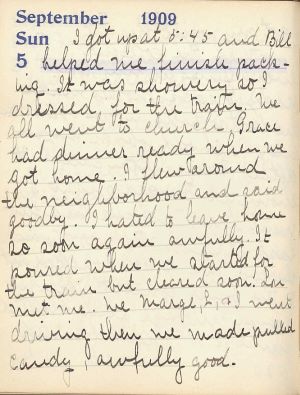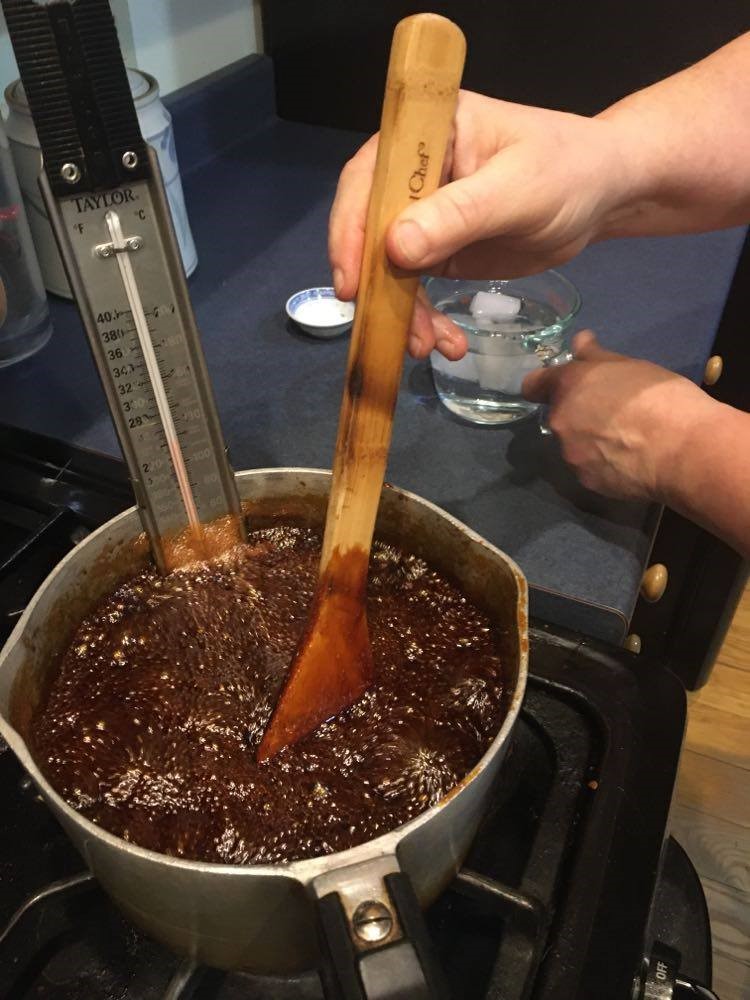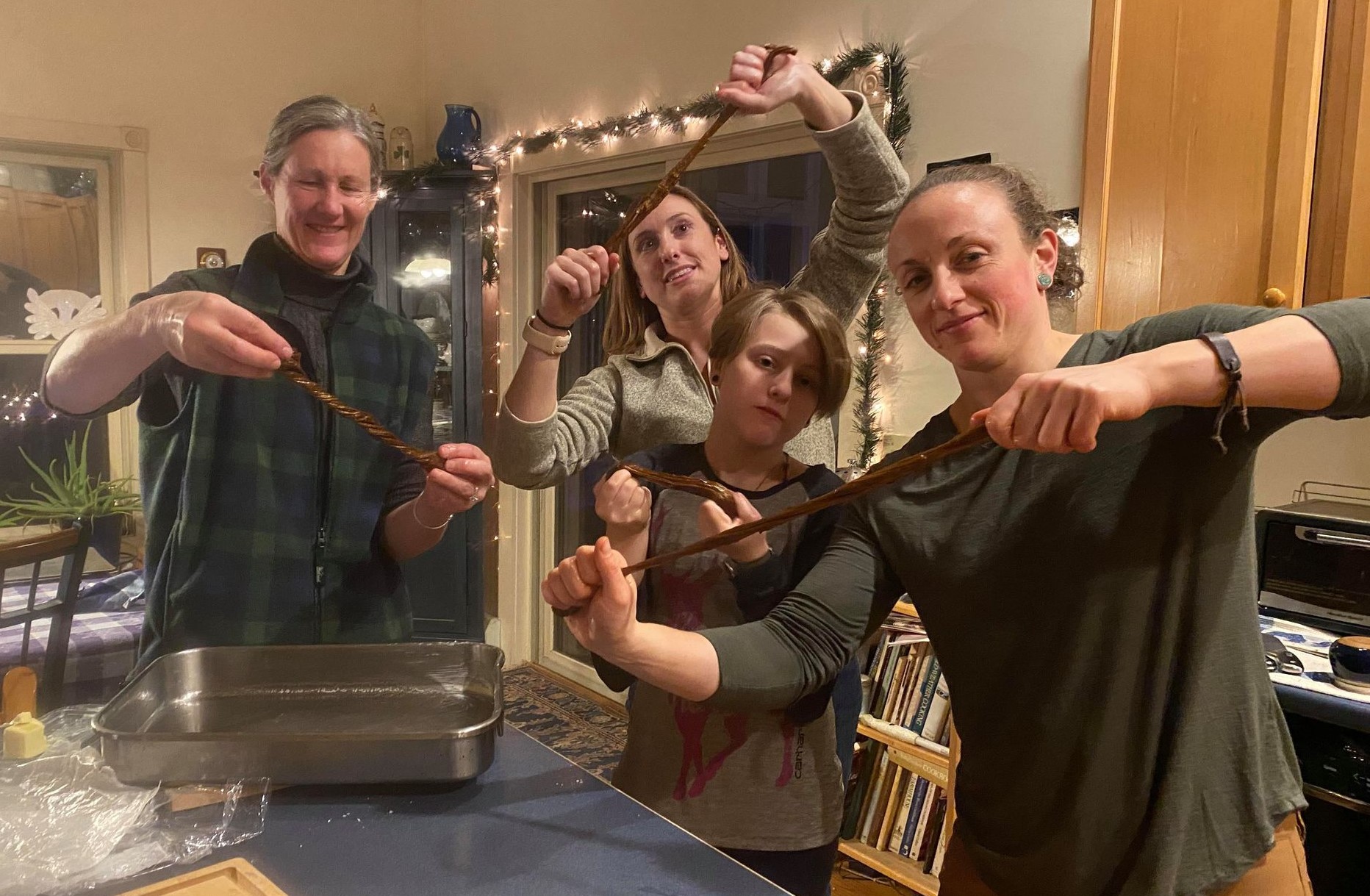Ingrid Bower continues our cookbook series with a post about making molasses taffy.
December is generally known as a time to gather and celebrate with friends and family. It is a time when even mageirocophobes (those with a fear of cooking) break out the measuring cups and cookie sheets from the depths of their kitchen cabinets to recreate the cookies and candies that their grandmothers used to make. My kitchen is no different.
In pre-COVID years, I have spent hours in the kitchen preparing one to two dozen different types of cookies and candy to share with my wonderful neighbors who generously allow us to run our sled dogs or graze our sheep on their properties. This year was different. I purchased “safe,” boxed chocolates for my neighbors and made only a few batches of cookies for the family. But this tradition of sugary neighborliness did lead me to a subject for our second Vermont cookbooks post.

Lamson’s Sept. 5, 1909 diary entry describes a very busy Sunday, concluding with “… then we made pulled candy, awfully good.”
The inspiration for the late December experiments in my kitchen came from the diaries of Genieve Lamson that we transcribed as part of our pandemic transcription project. Genieve Amelia Lamson was born in 1887 to Whitcomb E. and Hannah A. Lamson of Randolph, Vermont. She traveled widely and was well educated. She taught at Vassar College among many other career ventures, but eventually returned to her family home where she lived until her death in 1966. Lamson was a prolific diarist, and our Genieve Lamson Papers include her diaries from 1908-1910. The diaries illustrate the relatively carefree, socially active life of a young woman at the turn of the century. She was an avid baker and candy maker and attended many parties, some of which included “candy-pulls.”
My interest was piqued by these candy pulls. As I dug deeper, I found that they were popular party activities in the nineteenth century and had several resurgences in the twentieth century. In some cases the candy pull was also a courting activity where sweethearts could pair up and get close in a socially acceptable way.
Genieve Lamson attended or hosted several candy pulls for both “white candy” and molasses in 1908 and 1909, so once I decided to make taffy, my search for recipes in our Vermont cookbook collection focused on approximately that time period. The 1891 Ladies’ Aid Society of the Universalist Parish of Bellows Falls cookbook and the 1902 Crystal Lake Cook Book from the Barton Women’s Literary Club have appealing and seemingly authentic recipes of the time, and so the fun began.
We started with the 1891 recipe, which is basically just a list of ingredients with very brief instructions: “Two cups molasses, one cup sugar, one tablespoonful vinegar, butter size of walnut; boil twenty minutes, then add one teaspoonful [baking] soda; cool and pull.” Being uneasy with these minimal directions, we found a modern molasses candy recipe. Using a candy thermometer we were guided to about the correct temperature in those twenty minutes.
Since we had no idea how long we should cool the molten candy we again turned to the modern recipe, which led us astray a bit and we tried to work the candy too soon, causing a portion of it to harden to the sides of the pan like concrete. The salvaged portion cooled properly and as we pulled and folded and pulled over and over again, the color changed from a dull brown to an attractive metallic bronze and the consistency changed from somewhat brittle to soft and taffy-like. We twisted the long cords of candy together and cut them into bite size pieces and then wrapped them in waxed paper to share. As to taste, reviews were mixed. I loved it! But I enjoy the flavor of molasses. Those who are not molasses fans did not care for this candy.
A week later we tried the 1902 recipe, which calls for much less molasses and provides more detailed instructions. The temperature of this batch rose much more quickly than the last and caught us off guard and we allowed it to get to too high a temperature. We did succeed in cooling it properly, so, though the candy was more brittle than it should have been, the pulling was more successful. The flavor of this batch was much milder, like a “Werther’s Original,” and was a big hit with all who tasted it.
Due to COVID, having a candy pull party was a bit tricky, but, following the Governor’s guidelines, we included a “trusted family” in the creation of our second batch, so that our experience felt somewhat authentic. It was a lot of fun to include this historic aspect of gathering and neighborliness and I hope to continue this tradition for years to come.



